This article was co-authored by Francisco Gomez and by wikiHow staff writer, Danielle Blinka, MA, MPA. Francisco Gomez is the Head Coach at the FIT Potato Gym, a training gym established in 2001 in the San Francisco Bay Area. Francisco is a former competitive runner who helps endurance athletes train for major marathons like the Boston Marathon. Francisco specializes in Injury Rehab, Flexibility, Marathon Training, and Senior Fitness. He has a B.S. in Nutrition and Exercise Physiology & Running.
There are 9 references cited in this article, which can be found at the bottom of the page.
This article has been viewed 255,135 times.
Stepping into icy cold water doesn't sound like much fun, but an ice bath might help you reach your goals. You can use ice baths to relieve soreness after a workout and reduce inflammation in your body, though doing so will likely reduce your muscle gains.[1] Additionally, you might use ice baths for a burst of energy to make you productive or to help with depression and anxiety.[2] While ice baths are mostly safe, it’s important that you don’t stay in the water longer than 5-10 minutes.
Steps
Soaking After a Workout
-
1Fill your tub halfway with cold water. Since the ice and your body will increase the water volume, don’t worry about filling up the tub. Turn on the cold water and wait for the water level to rise about halfway up the side of the tub. Then, shut off the water faucet.[3]
- Use cold water because your ice may melt too quickly if your water is too warm.
- If you feel like your water level is too low, you can always turn on the cold water to raise the water level.
- If you don’t have a bathtub, use a kiddie pool or large plastic tub for your ice bath. Use your garden hose to fill it up.
-
2Add three 5 lb (2.3 kg) bags of ice to the water to chill it to 55 to 60 °F (13 to 16 °C). Use store-bought ice or ice from your freezer, depending on what’s most convenient to you.[4] Pour the ice into your bath in small quantities to lower the temperature. Use a thermometer to check the water’s temperature and stop adding ice when it reaches about 55 to 60 °F (13 to 16 °C).[5]
- If you don't have a thermometer, you can estimate the temperature by plunging your elbow beneath the surface. You'll feel some discomfort but it shouldn't burn your skin.
- At first, you might use slightly warmer water so you don’t feel shocked by the temperature. Add just enough ice to lower your water temperature to around 60 to 70 °F (16 to 21 °C) to get you used to an ice bath. Slowly decrease the temperature of your ice bath by 1-2 degrees each time you take an ice bath until you get down to about 55 °F (13 °C).
Advertisement -
3Take your ice bath within 30 minutes of exercise. Ice baths are only helpful if you take them right after a workout. Plan your bath immediately after you finish a hard cardio or strength training workout or competition.[6]
- Don’t take an ice bath before a workout or competition because it will cause muscle stiffness and may worsen your performance.
- Ice baths are helpful because they remove waste products that your body produces during a workout, such as lactic acid. This helps your body recover from the workout faster and reduces swelling in your muscles. Additionally, your body may feel less tired since lactic acid may cause fatigue.[7]
-
4Shower off before your ice bath to prevent skin conditions. During a workout, your body naturally sweats to cool itself down. Additionally, you will likely come into contact with equipment, flooring, or terrain that exposes you to bacteria and dirt. While it’s rare, it’s possible that bacteria or grime on your skin can lead to a skin condition if you get in an ice bath dirty. Before your bath, take a short, lukewarm shower to soap up so that you’ll be clean when you get in the bath.[8]
- If you are sharing an ice bath with fellow athletes, it’s especially important that you wash off beforehand. Sharing a bath without washing increases the risk of infection for everyone who uses it.
-
5Put on shorts and foot booties to protect sensitive areas. Cold water can damage sensitive skin, so you might decide to wear protective clothing over some parts of your body. Swimming trunks, shorts, or briefs can help keep your genital area warm. Similarly, toe warmers or booties made out of wetsuit material can keep your feet from freezing.[9]
- You can get booties at sports stores, surf shops, or online. If you can't get booties, try wearing socks.
- If you are only soaking the lower half of your body, you might even wear a sweatshirt in the bath so your upper body stays warm.
-
6Submerge your lower body under the ice water slowly. Getting into the cold water too quickly can shock your system and may make your heart race too fast. Give yourself time to adjust to the cold by slowly entering the water. As you get into the bath, take slow, deep breaths to stay calm.[10] Start with your feet, then ease the rest of your lower body into the water. [11]
- It’s okay to sit on the side of the tub with just your feet in the water if the water is too uncomfortable. Take as much time as you need to adjust to the cold water.
-
7Dip your upper body into the water if desired when you're ready. When you feel like you’ve adjusted to the cold temperature, sink lower in the water to immerse your arms, shoulders, and chest. Stay under the water only if you feel like you can tolerate it. If you start to feel too cold or shaky, lift your body out of the water immediately.[12]
- Always do what feels comfortable to you, and don’t push yourself. Cold water can be very shocking to your system, so take things slow.
- You may not want to soak your upper body if you’re only trying to soothe your leg and hip muscles. Do what’s right for you.
-
8Soak for 5-10 minutes to help you recover. Settle into the water and take deep breaths to help you relax. It may help to count your breaths, which can take your mind off the cold. Set a timer for 5-10 minutes and try to stay in your bath until the timer goes off.[13]
- If you can’t stand the cold, it’s okay to get out of your bath early. Don’t push your body past its limits.
- Put a towel outside your tub on the ground so you don't slip when you get out of the water.[14]
Variation: After you become accustomed to taking ice baths, you may increase the length of your bath to up to 20 minutes. However, never soak in ice water for longer than 20 minutes, as it can harm your skin or cause health problems.
Using Ice Baths for Energy or Mental Health
-
1Check with your doctor before using cold therapy to treat yourself. Ice baths may help you get a burst of energy or might help you improve your mood. However, they aren’t appropriate for everyone, especially if you have an underlying health condition. Talk to your doctor about why you want to try cold therapy and if it’s right for you.[15]
- For instance, taking ice baths can be dangerous if you have a heart condition. Your doctor can help you determine if you have any risks that might make it harmful to take an ice bath.
- Ice baths are a positive stressor that will likely give you a burst of adrenaline. Since adrenaline gives you energy, it's possible that a quick ice bath may help you feel more awake and productive. Additionally, cold water constricts your blood vessels in your extremities to preserve heat, which forces your blood to your core and brain. The flow of blood to your brain increases how much oxygen and nutrition reach your brain, which can improve your mental health.[16]
-
2Fill your tub halfway with cold water. Don’t fill up your tub because the ice and your body will raise the volume of the water. Turn on the faucet that controls the cold water and wait for the water to rise about halfway up the tub. Then, switch off the water faucet.[17]
- Use cold water because warm water will melt your ice too quickly.
-
3Add ice to lower the temperature to about 68 °F (20 °C). Use store-bought ice or ice from your freezer, whichever is most convenient to you. Drop a few handfuls of ice in the tub, then check the temperature with a thermometer. Continue to add ice in small amounts until the water reaches about 68 °F (20 °C).[18]
- If you like, it’s okay to lower your temperature so that it’s colder. However, don’t lower it below 55 °F (13 °C), which can harm your skin or your health.[19]
-
4Relax in the tub for about 5 minutes by taking slow, deep breaths. Sit back against the back of your tub and try to enjoy your soak. Breathe slowly in and out, drawing the air deep into your lungs. You might also count your breaths to help you relieve any tension in your body. Set a timer for 5 minutes and try to stay in the bath until it goes off.[20]
- Get out of the bath early if you feel too uncomfortable or feel like your heart is racing. Don’t push your body further than it’s ready to go.
-
5Take a 1-3 minute cold shower for an easier option. You can still get the benefits you want without soaking in a tub. Instead, stand under a cold shower for at least a minute. If you can stand it, stay under the water for a full 3 minutes.[21]
- For a daily energy boost, end your morning shower with a blast of cold water.
Tip: It’s okay to ease yourself into the cold water, if necessary. Start with a warm shower and slowly decrease the temperature over a 5-minute period. Then, finish your shower with a 1- to 3-minute blast of cold water.[22]
-
6Use cold therapy once or twice a day to improve your mood. Take your bath or shower early in the morning to improve your mood for that day. If you like, take another bath or shower later in the day. Continue using it as long as you feel like it’s helping you have more energy or to cope with your anxiety or depression.[23]
- Cold therapy isn’t a substitute for working with a therapist or taking medication for anxiety or depression. Don’t stop any of your prescribed treatments unless your doctor says it’s okay.
Tip: Cold therapy works best if you do it consistently. Take a cold bath or shower daily to see if it helps you get the results you want.[24]
Warming Yourself up After an Ice Bath
-
1Towel off with a dry towel after your bath. Get out of the tub and immediately wrap a towel around yourself. Pat yourself down to remove all of the cold water from your skin.[25]
- If it’s possible, use a towel that’s straight out of the dryer so it’s still warm.
-
2Put on sweats or cover yourself with a warm blanket to warm yourself. Once your skin is dry, pull on thick clothing to help raise your body temperature. Wear sweats or something similar, like a thick bathrobe. You might also cover yourself with a blanket.
- If you’re shivering, add more clothing to help you warm up faster.
-
3Increase your body temperature by sipping on a hot beverage. Hot coffee, tea, or broth will help you warm up faster. Brew your coffee or tea or heat up some broth. Then, take small sips of your beverage so you don’t shock your body.
- If you want energy, you might drink a caffeinated drink.
- If you’re trying to calm down, stick to decaffeinated coffee, herbal tea, or broth.
-
4Wait 2 hours before you take a warm bath or shower if possible. Taking a warm shower or bath too soon after an ice bath may reduce the effects of the cold therapy, no matter your goal. Unless you’re having trouble warming yourself back up, wait at least 2 hours before you take a warm bath or shower.[26]
- Go ahead and take a warm bath or shower if you’re still shivering and feeling cold after putting on thick clothing and drinking a warm beverage. The warm water should warm you up faster.
Community Q&A
-
QuestionCould I train and then take an ice bath the next day?
 Amaiyah WardCommunity AnswerTake ice baths immediately after training. Generally, you should take an ice bath within 30 minutes of the end of your training session. Some gyms may offer ice baths in their facilities. Alternatively, you can keep a bag of ice at home in your freezer for when you need to rest your muscles.
Amaiyah WardCommunity AnswerTake ice baths immediately after training. Generally, you should take an ice bath within 30 minutes of the end of your training session. Some gyms may offer ice baths in their facilities. Alternatively, you can keep a bag of ice at home in your freezer for when you need to rest your muscles.
Warnings
- Do not take ice baths that are colder than 55 °F (13 °C). Hypothermia or muscle damage could result.[29]⧼thumbs_response⧽
- Do not stay in an ice bath longer than 20 minutes, as this can damage your muscles. If you start feeling too cold, uncomfortable, or in pain, get out of the bath.[30]⧼thumbs_response⧽
- Ice baths will not help you build muscle or improve your strength. In many cases, they can actually reduce gains. You should only use an ice bath if you need to reduce soreness.[31]⧼thumbs_response⧽
References
- ↑ https://www.stack.com/a/ice-baths
- ↑ https://www.psychologytoday.com/us/blog/inner-source/201407/cold-splash-hydrotherapy-depression-and-anxiety
- ↑ https://www.self.com/story/is-taking-an-ice-bath-actually-worth-the-pain
- ↑ https://www.mensjournal.com/health-fitness/benefits-of-cold-therapy/
- ↑ https://www.stack.com/a/ice-baths
- ↑ https://www.stack.com/a/ice-baths
- ↑ https://www.mensjournal.com/health-fitness/benefits-of-cold-therapy/
- ↑ https://www.stack.com/a/ice-baths
- ↑ https://www.mensjournal.com/health-fitness/benefits-of-cold-therapy/
- ↑ Francisco Gomez. Athletic Trainer. Expert Interview. 25 October 2019.
- ↑ https://www.self.com/story/is-taking-an-ice-bath-actually-worth-the-pain
- ↑ https://www.mensjournal.com/health-fitness/benefits-of-cold-therapy/
- ↑ Francisco Gomez. Athletic Trainer. Expert Interview. 25 October 2019.
- ↑ Francisco Gomez. Athletic Trainer. Expert Interview. 25 October 2019.
- ↑ https://www.psychologytoday.com/us/blog/inner-source/201407/cold-splash-hydrotherapy-depression-and-anxiety
- ↑ https://www.psychologytoday.com/us/blog/inner-source/201407/cold-splash-hydrotherapy-depression-and-anxiety
- ↑ https://www.ncbi.nlm.nih.gov/pmc/articles/PMC5025014/
- ↑ https://www.psychologytoday.com/us/blog/inner-source/201407/cold-splash-hydrotherapy-depression-and-anxiety
- ↑ http://onlinelibrary.wiley.com/doi/10.1113/JP270570/full
- ↑ https://www.psychologytoday.com/us/blog/inner-source/201407/cold-splash-hydrotherapy-depression-and-anxiety
- ↑ https://www.ncbi.nlm.nih.gov/pmc/articles/PMC5025014/
- ↑ https://www.ncbi.nlm.nih.gov/pubmed/17993252
- ↑ https://www.psychologytoday.com/us/blog/inner-source/201407/cold-splash-hydrotherapy-depression-and-anxiety
- ↑ https://www.ncbi.nlm.nih.gov/pmc/articles/PMC5025014/
- ↑ https://physoc.onlinelibrary.wiley.com/doi/full/10.1113/JP270570
- ↑ http://onlinelibrary.wiley.com/doi/10.1113/JP270570/full
- ↑ http://onlinelibrary.wiley.com/doi/10.1113/JP270570/full
- ↑ http://onlinelibrary.wiley.com/doi/10.1113/JP270570/full
- ↑ http://onlinelibrary.wiley.com/doi/10.1113/JP270570/full
- ↑ http://onlinelibrary.wiley.com/doi/10.1113/JP270570/full
- ↑ https://www.stack.com/a/ice-baths
About This Article
To start an ice bath, fill your bathtub halfway with cold water and add half of a bag of ice. Make sure to dip a thermometer into the water and add warm water if the temperature goes below 55 degrees Fahrenheit. Otherwise, you risk damaging your skin. Before hopping in, put on shorts and foot booties to protect your sensitive areas from getting too cold. When you first start taking ice baths, only submerge the lower half of your body, because you might shock your body by overdoing it. After 6 to 8 minutes of relaxing in the tub, get out, dry off, and put on a sweatshirt to warm yourself up. Avoid spending more than 20 minutes in an ice bath, as it could be dangerous to your health. For more help from our Fitness co-author, like how to fit ice baths into your workout routine, read on!
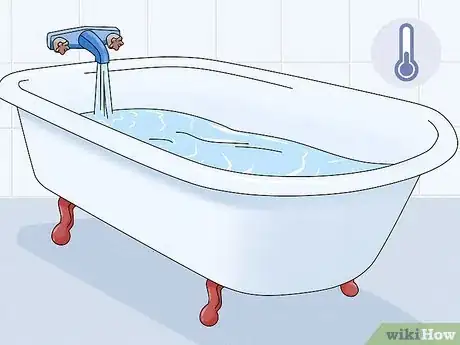
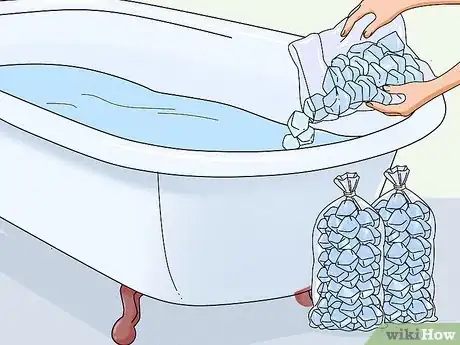
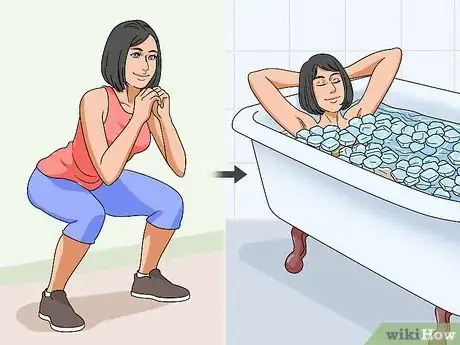

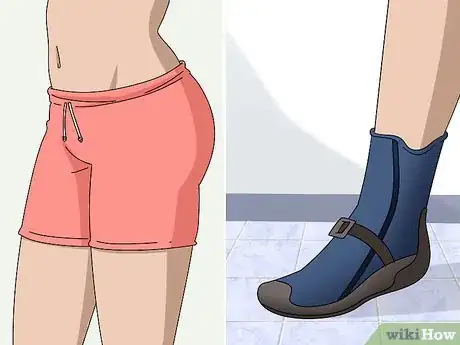



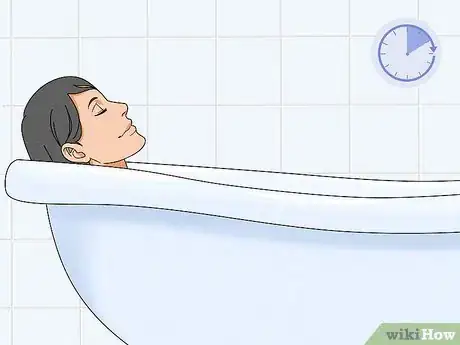










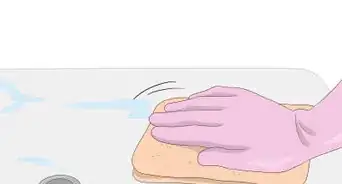





















































Medical Disclaimer
The content of this article is not intended to be a substitute for professional medical advice, examination, diagnosis, or treatment. You should always contact your doctor or other qualified healthcare professional before starting, changing, or stopping any kind of health treatment.
Read More...